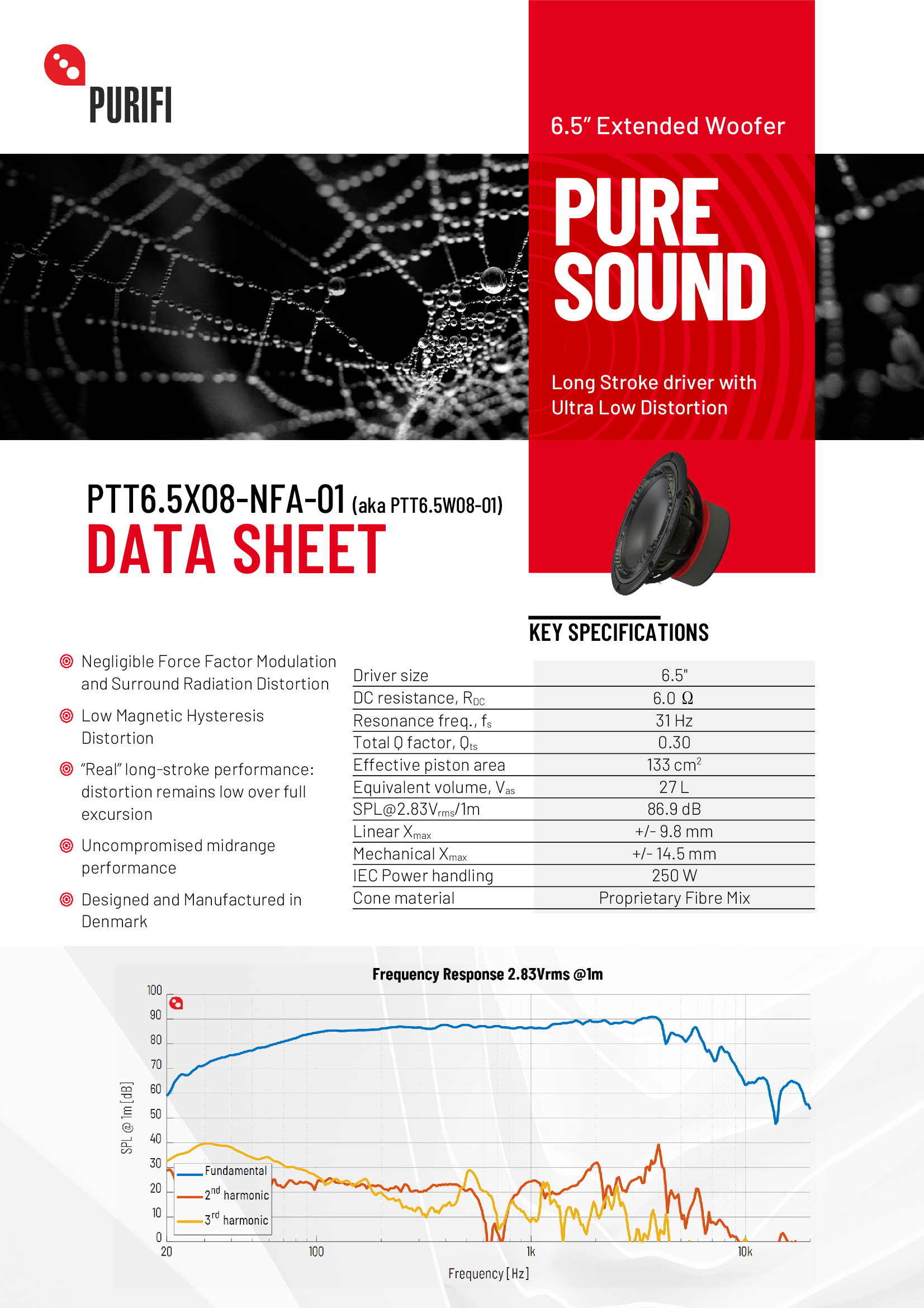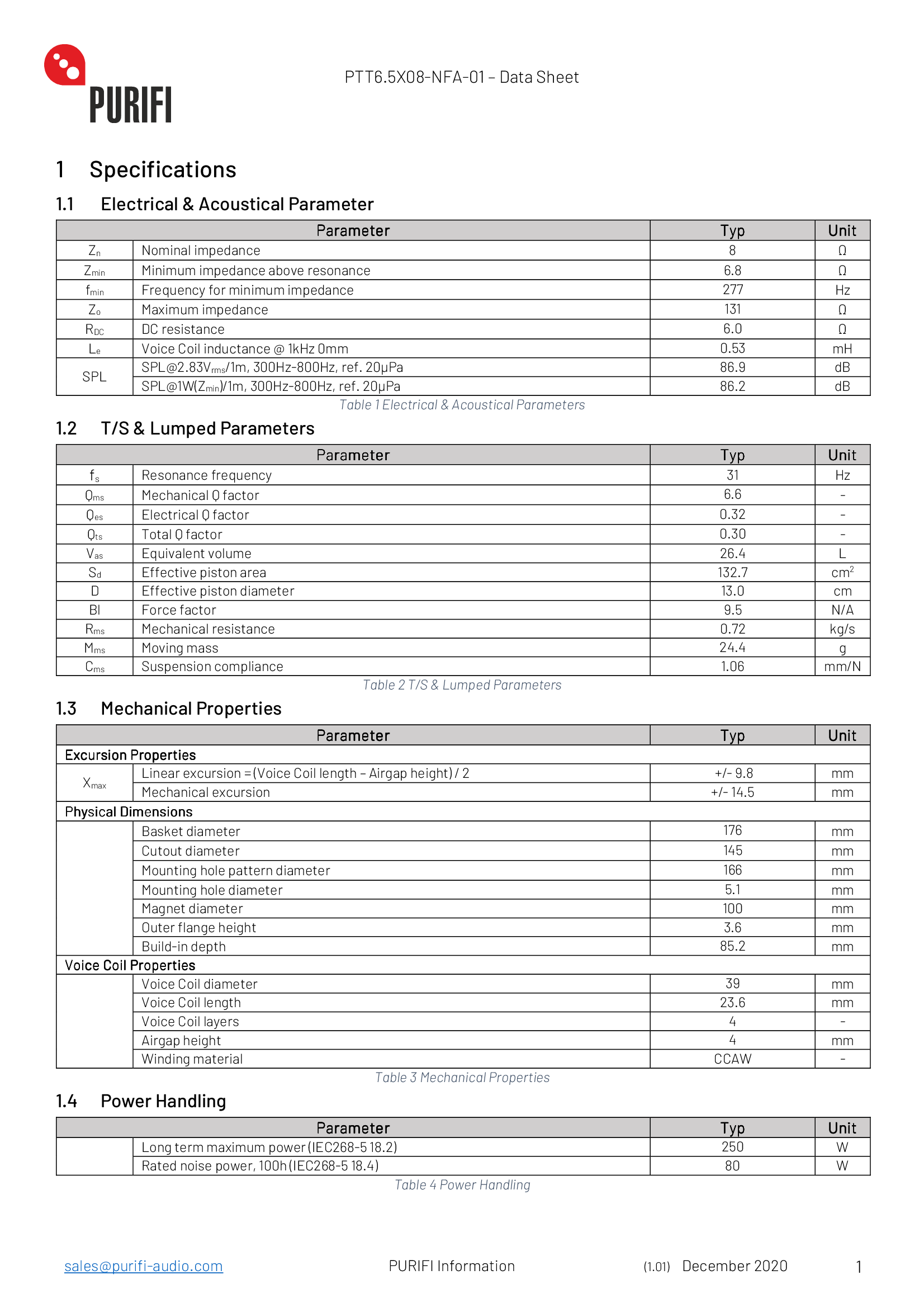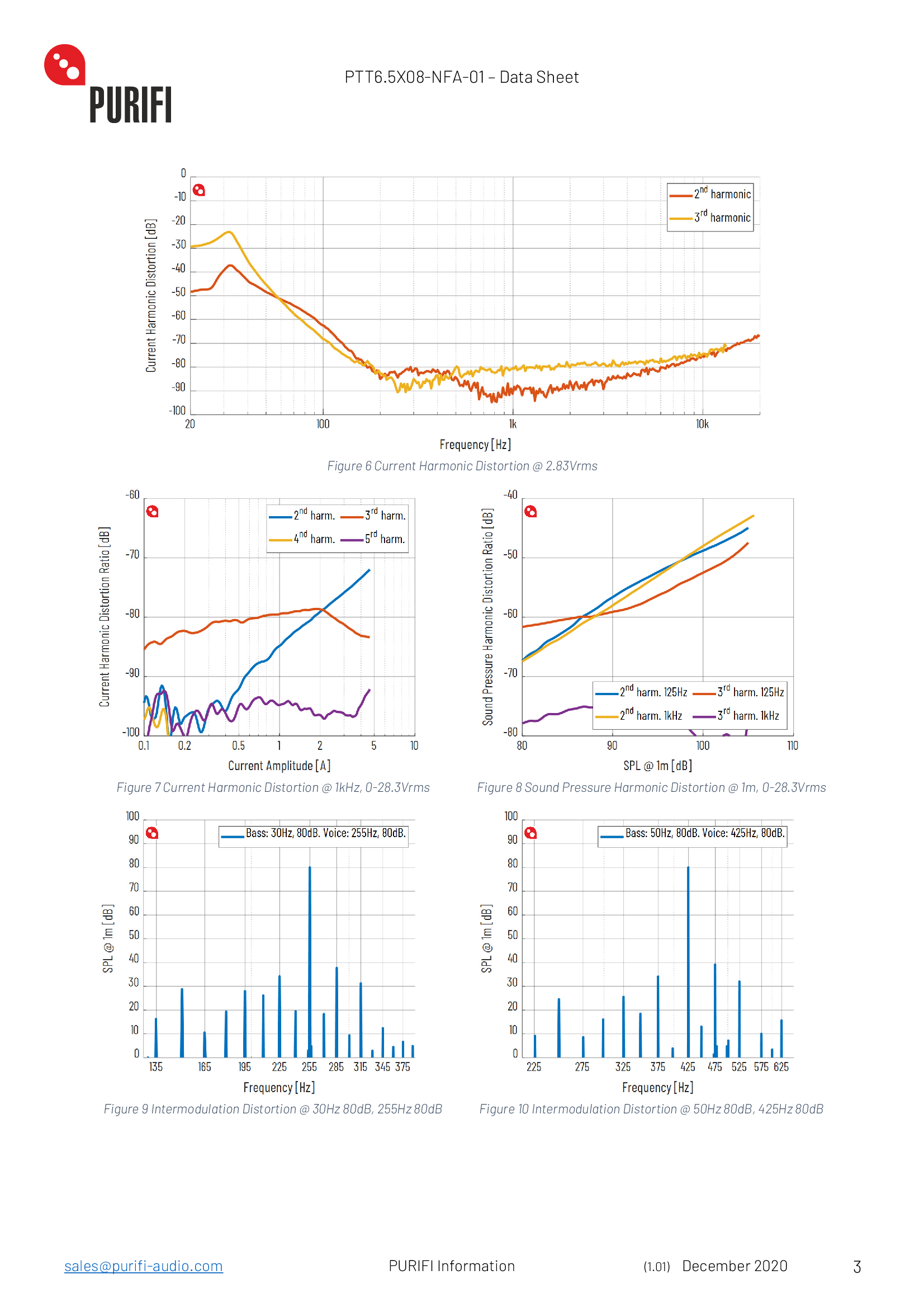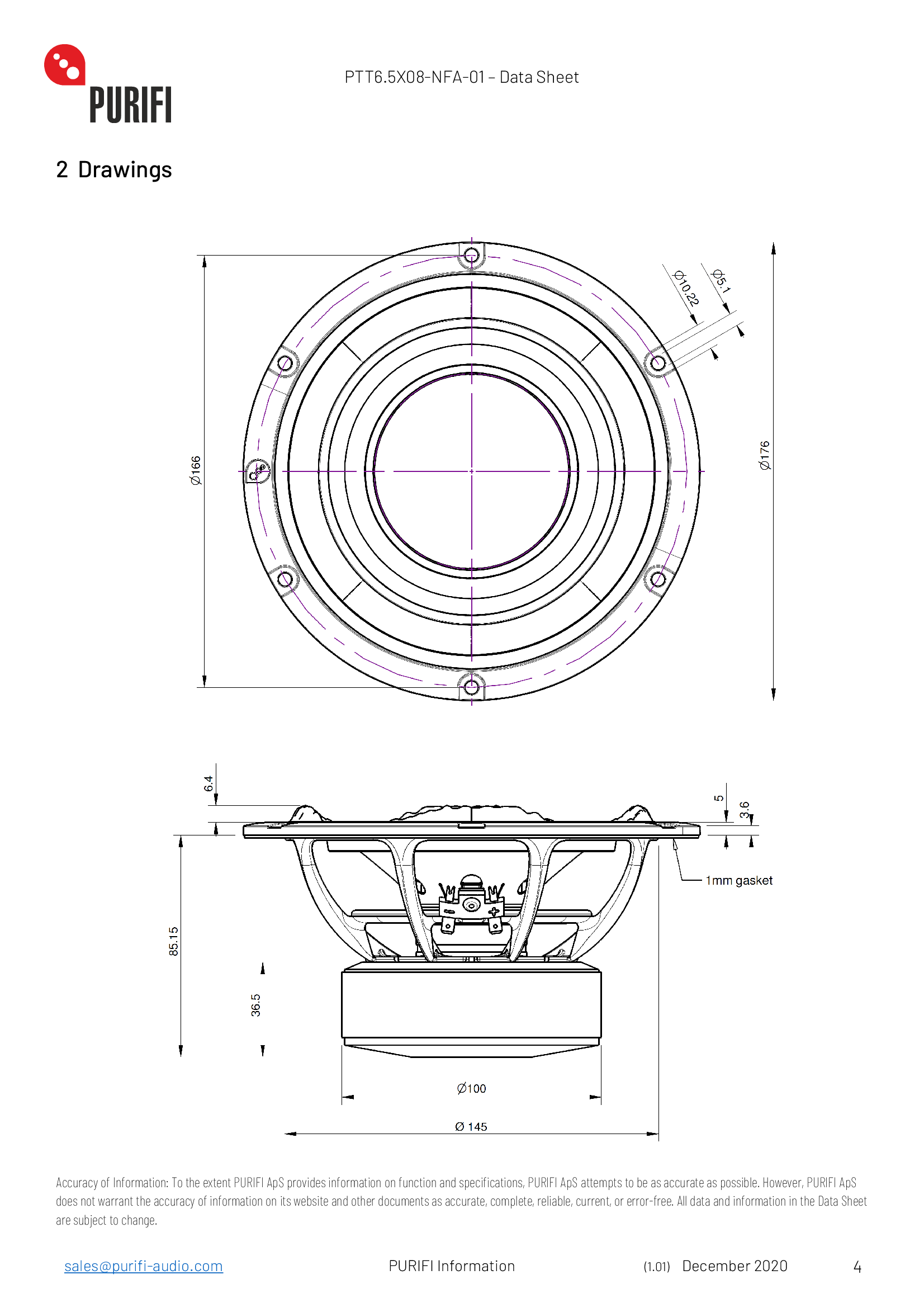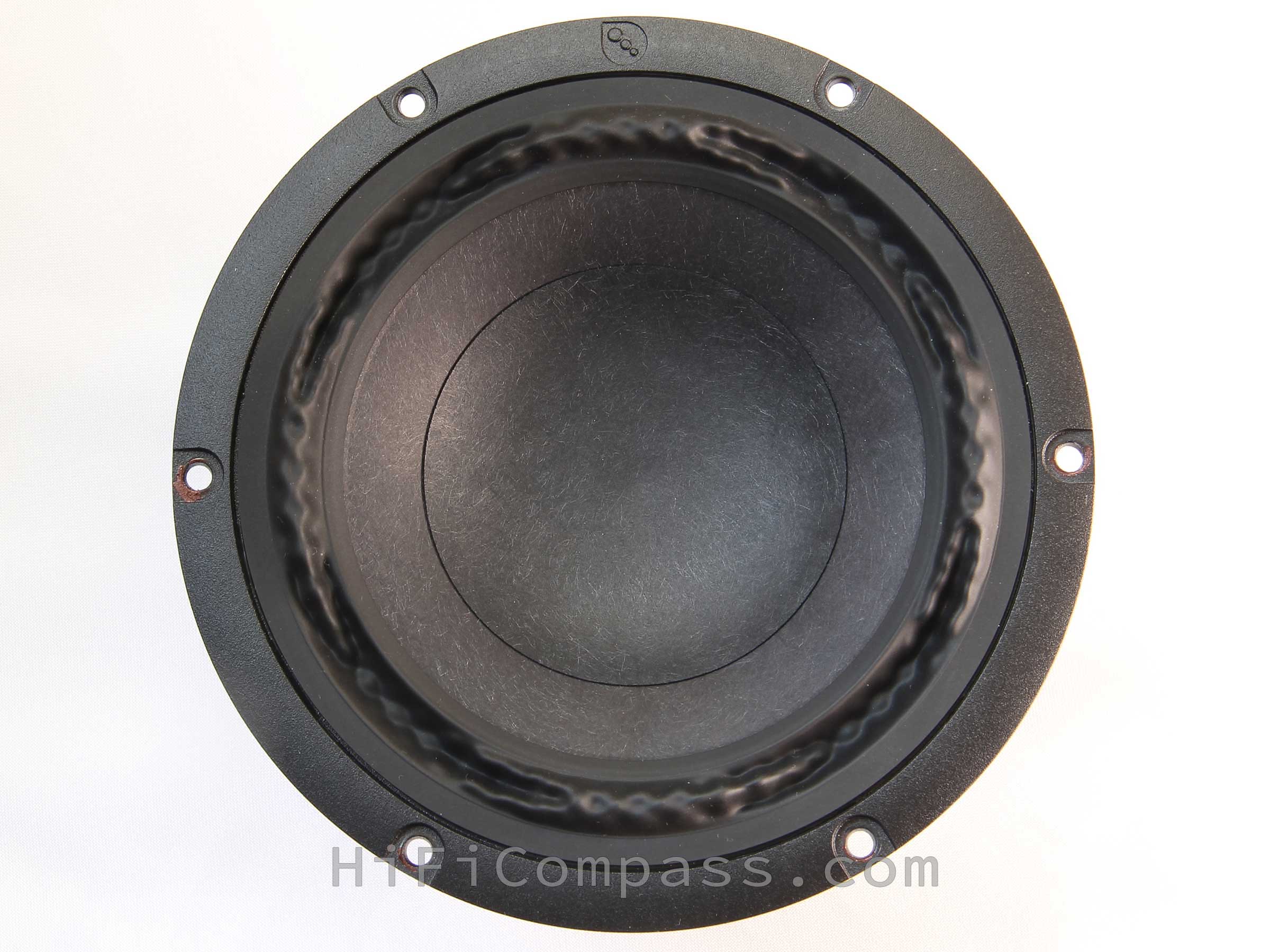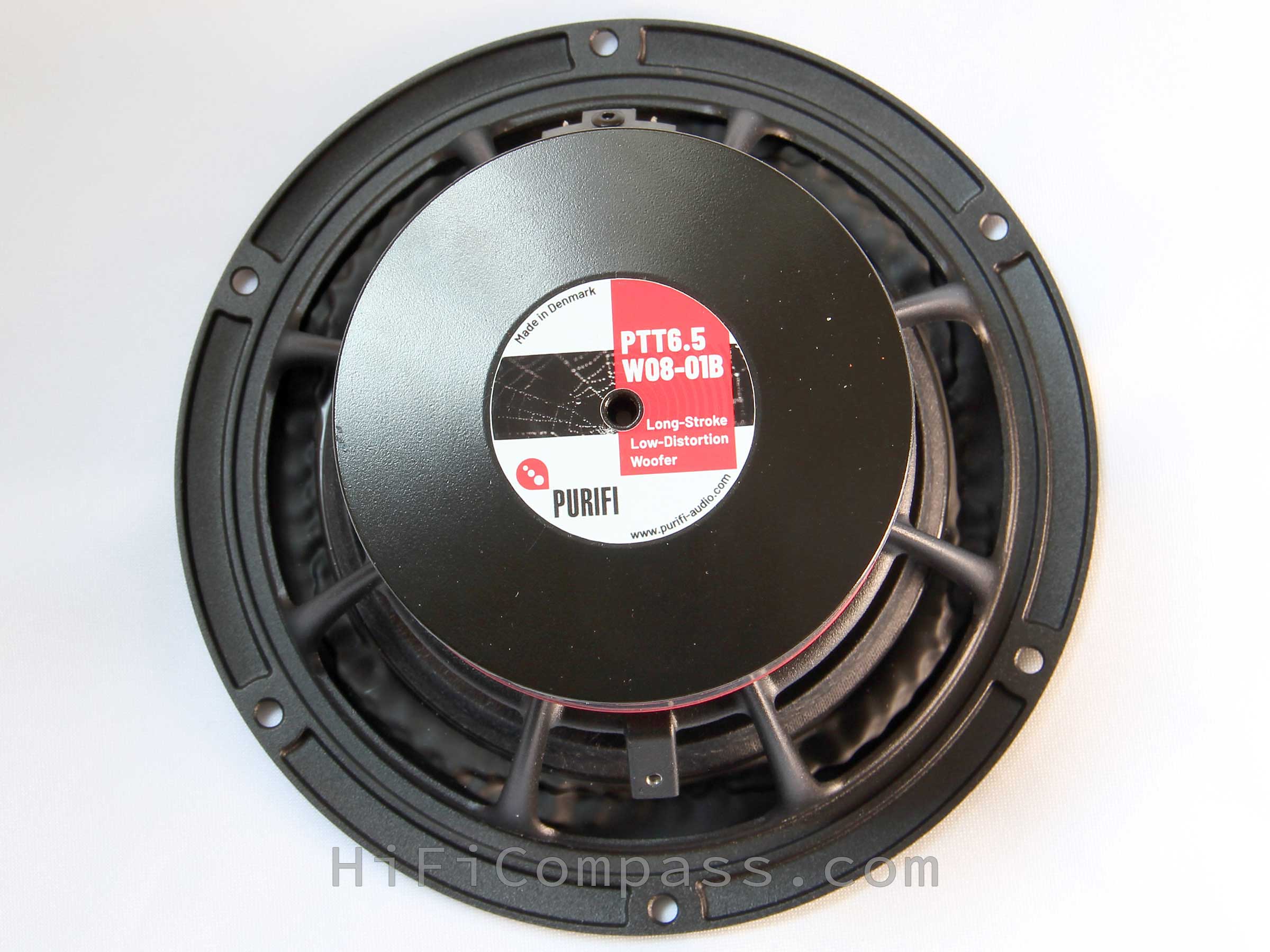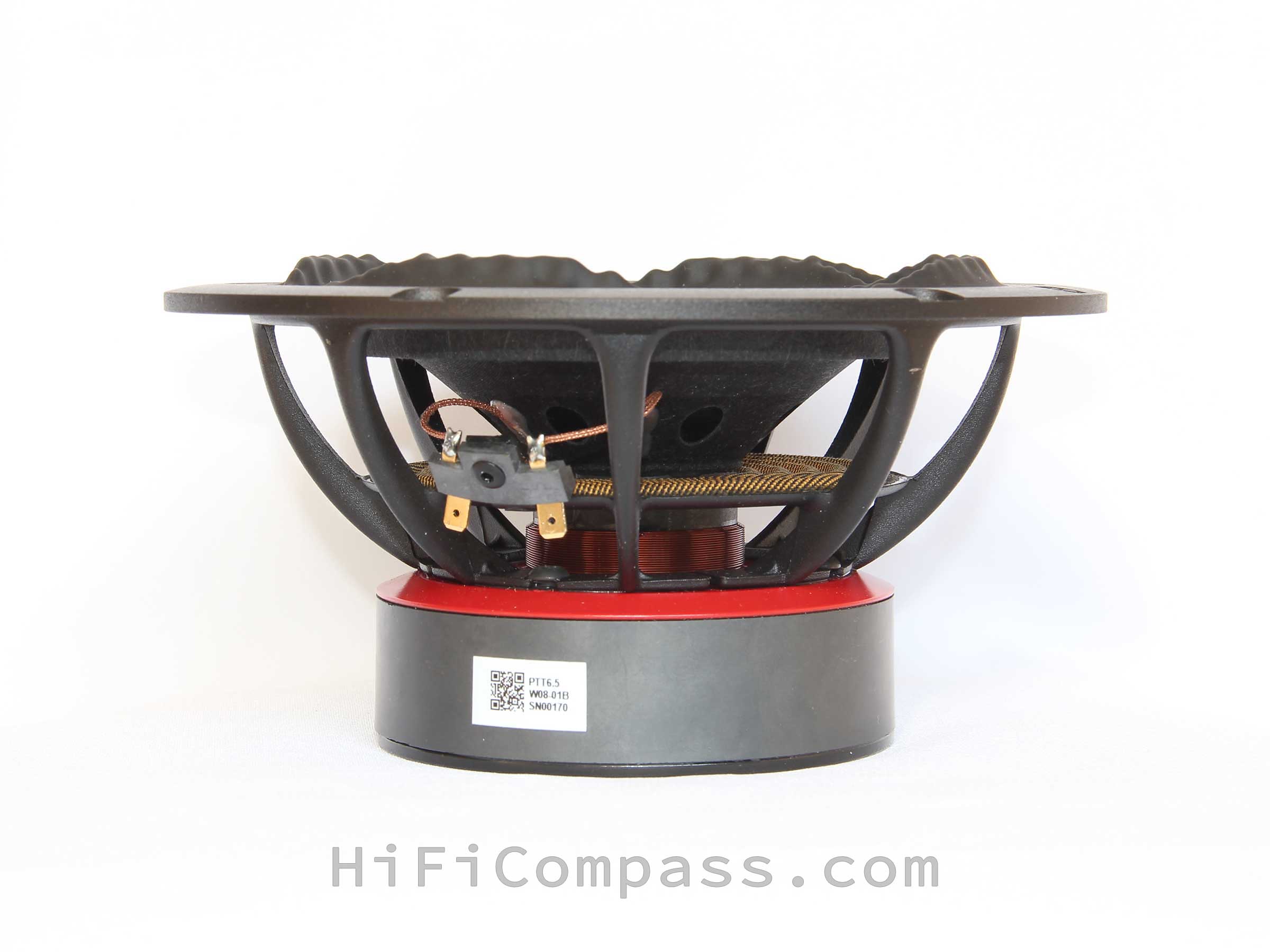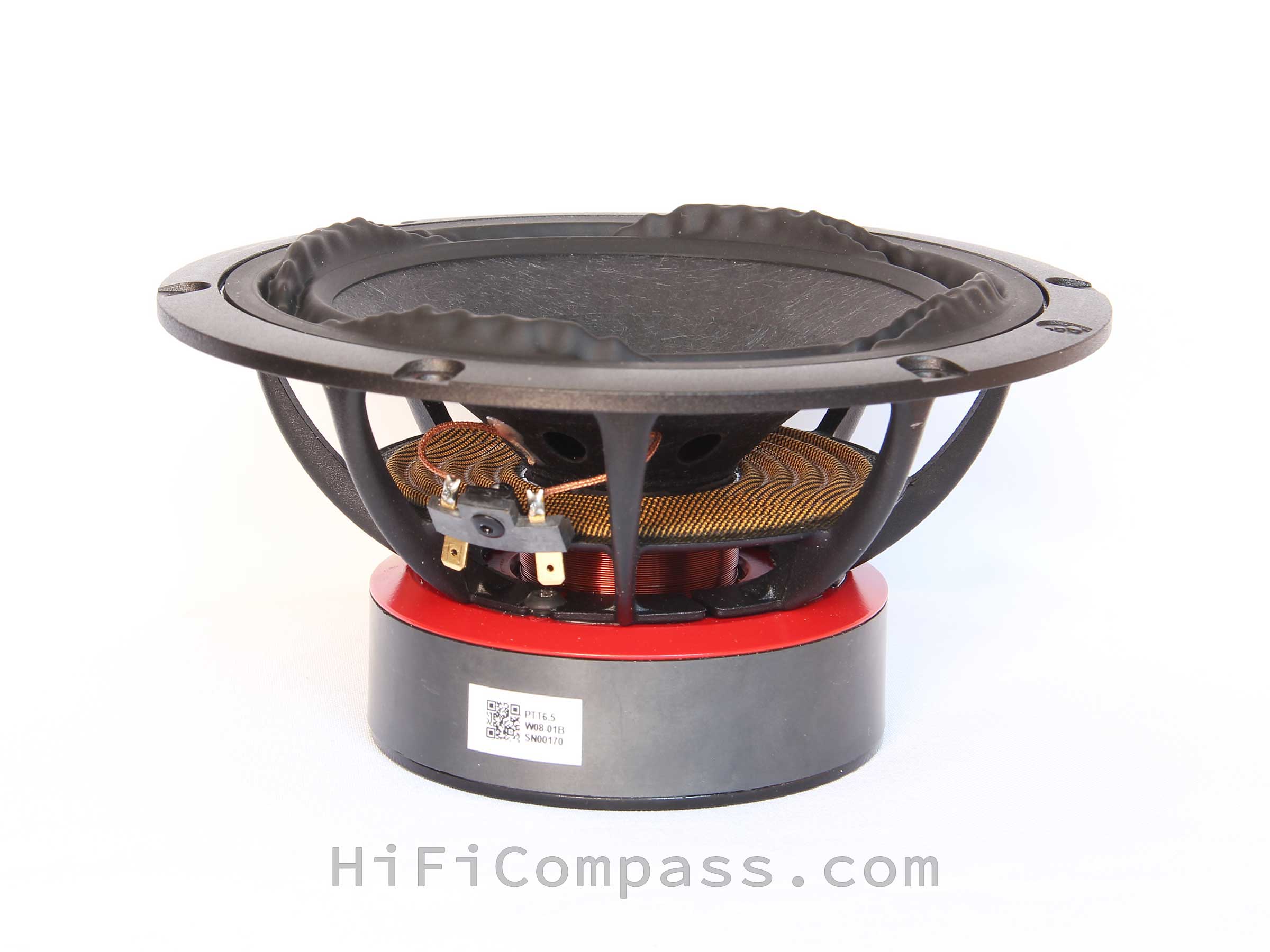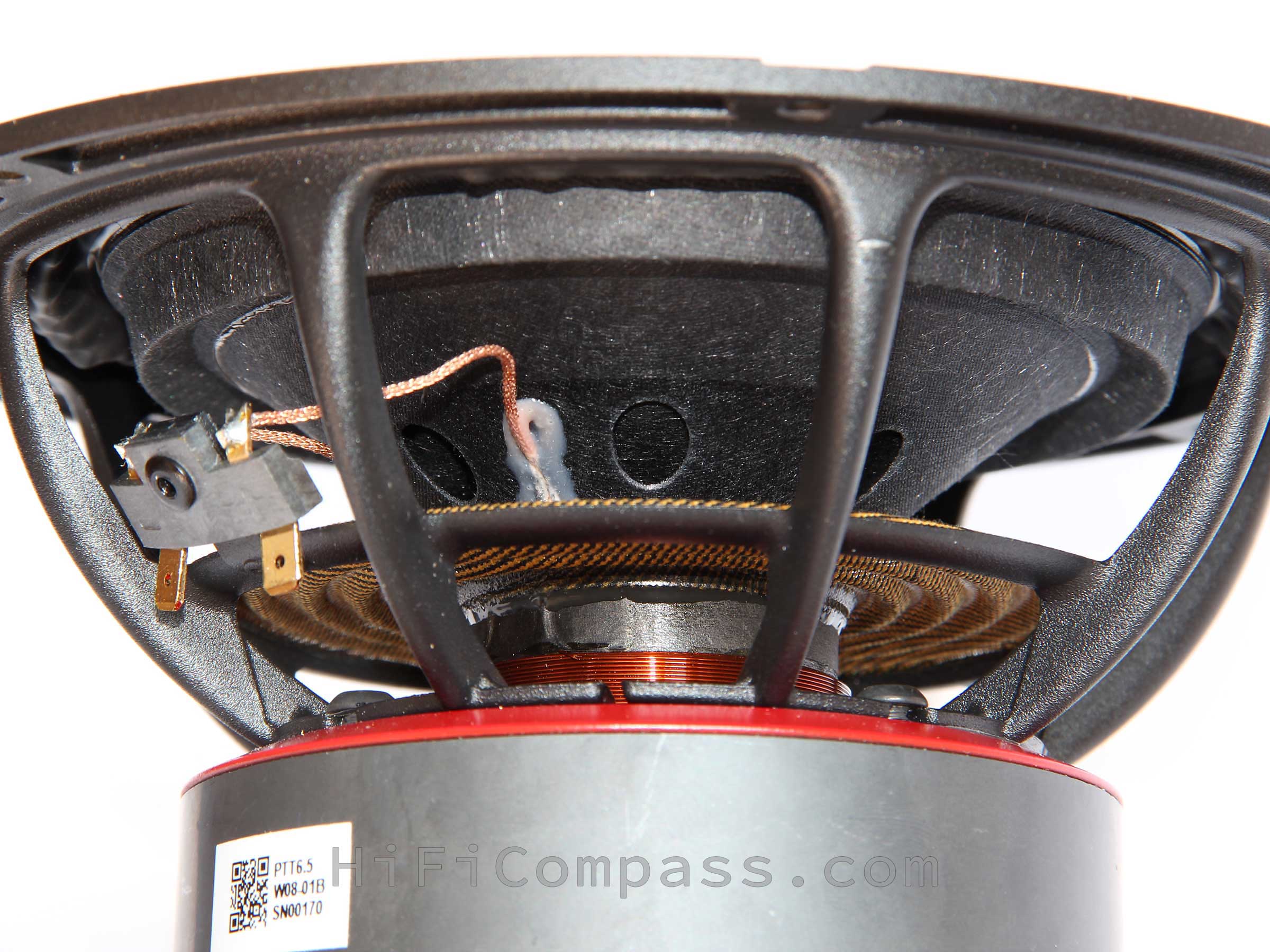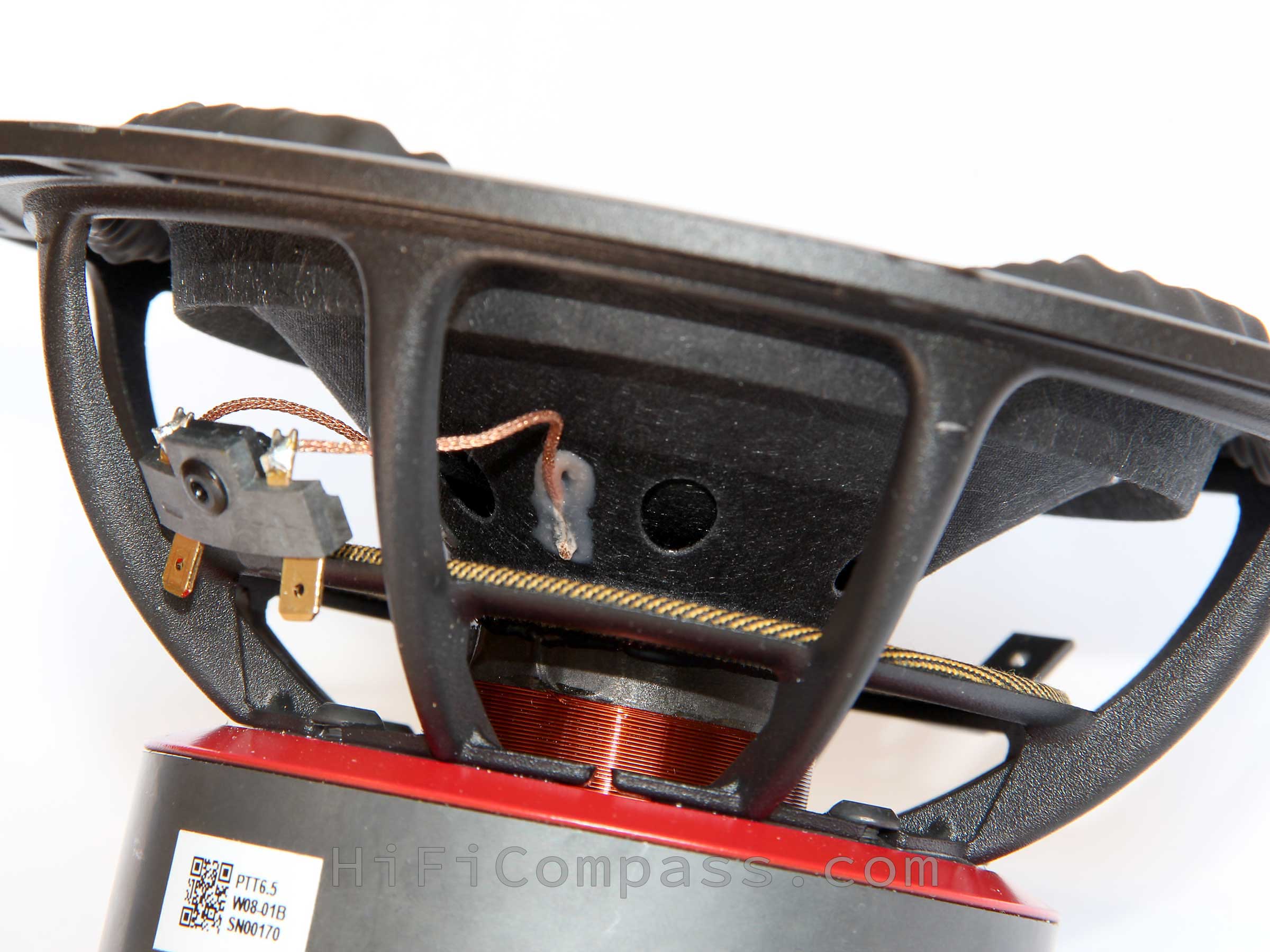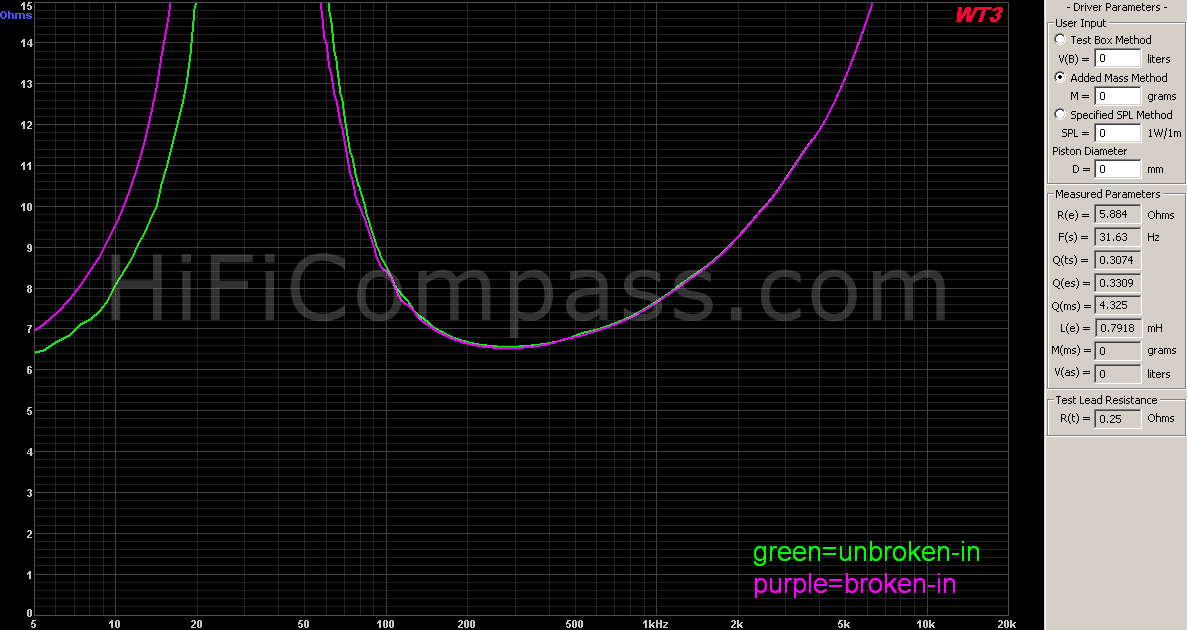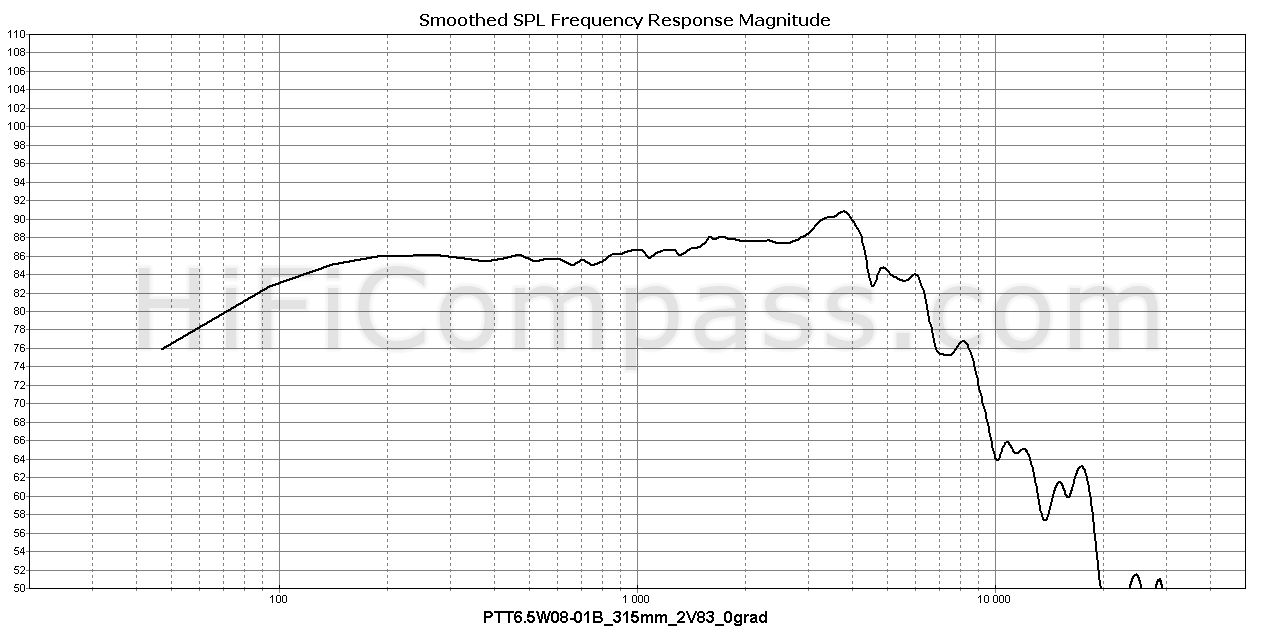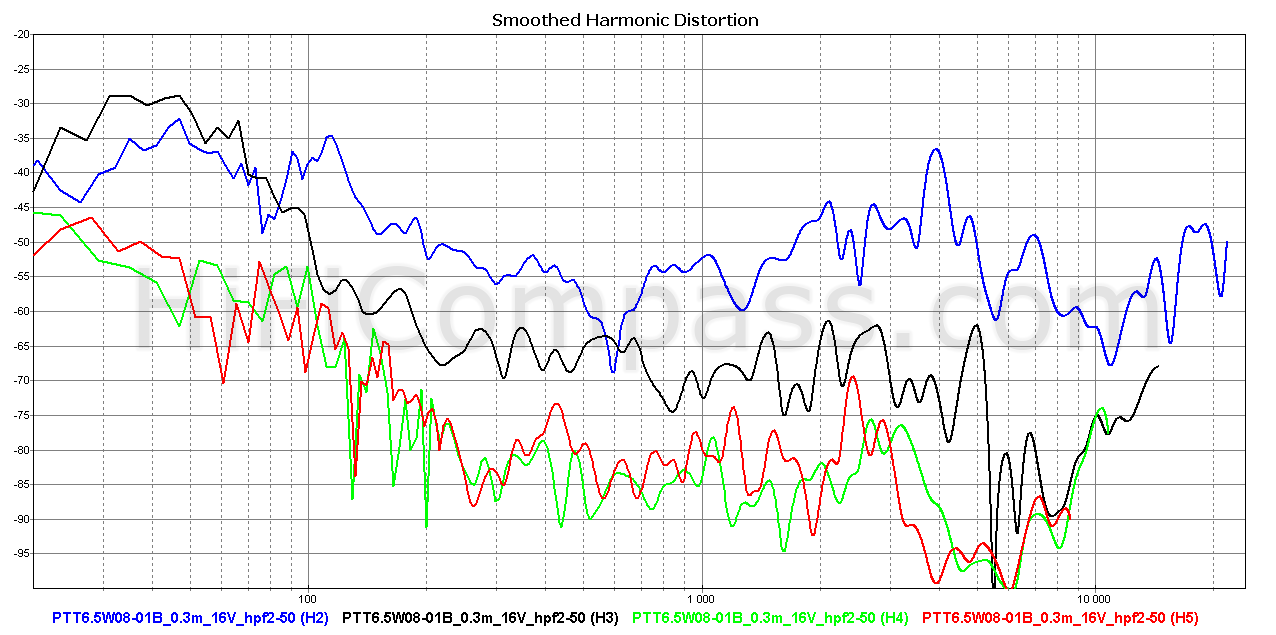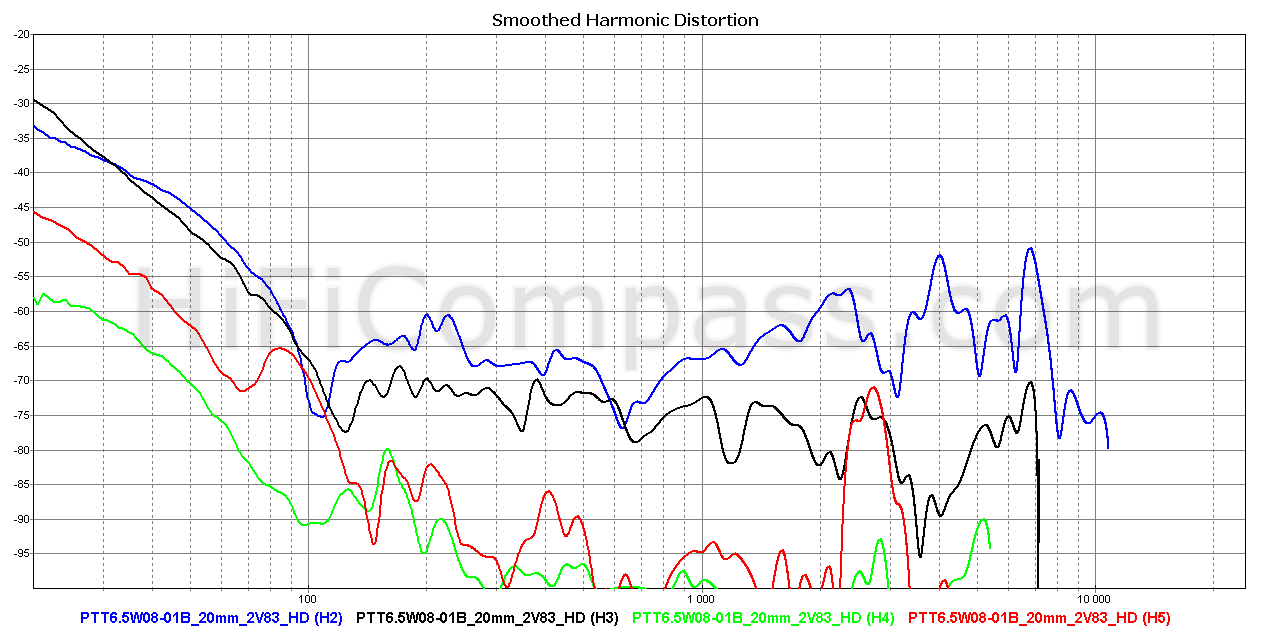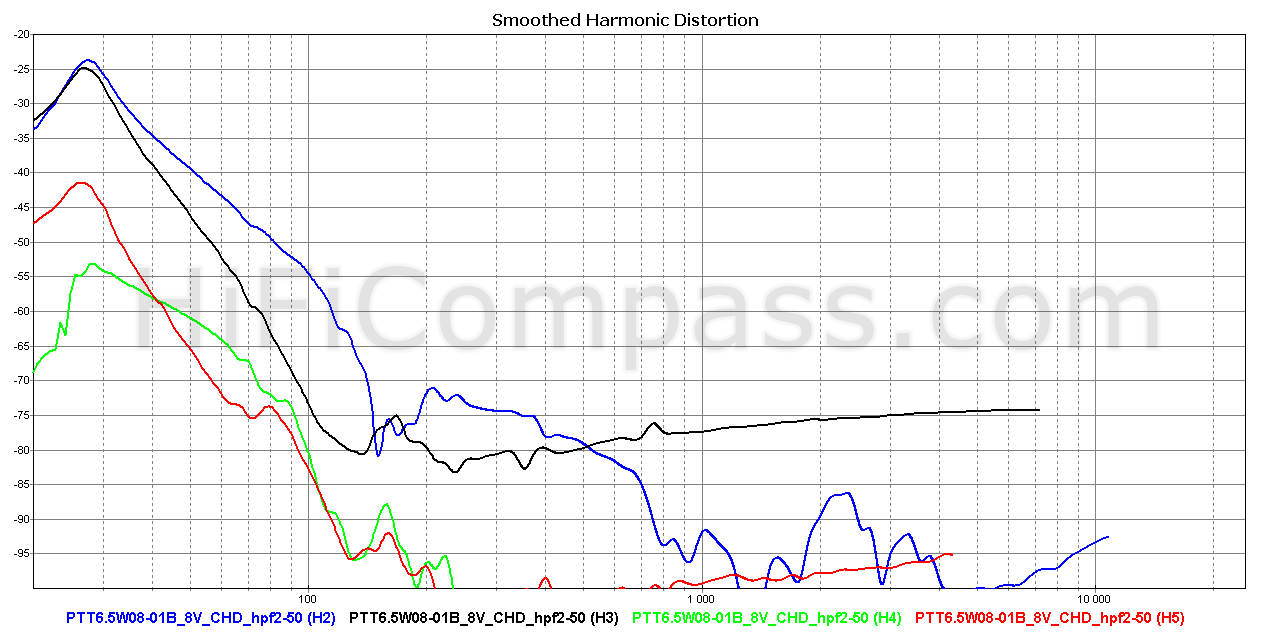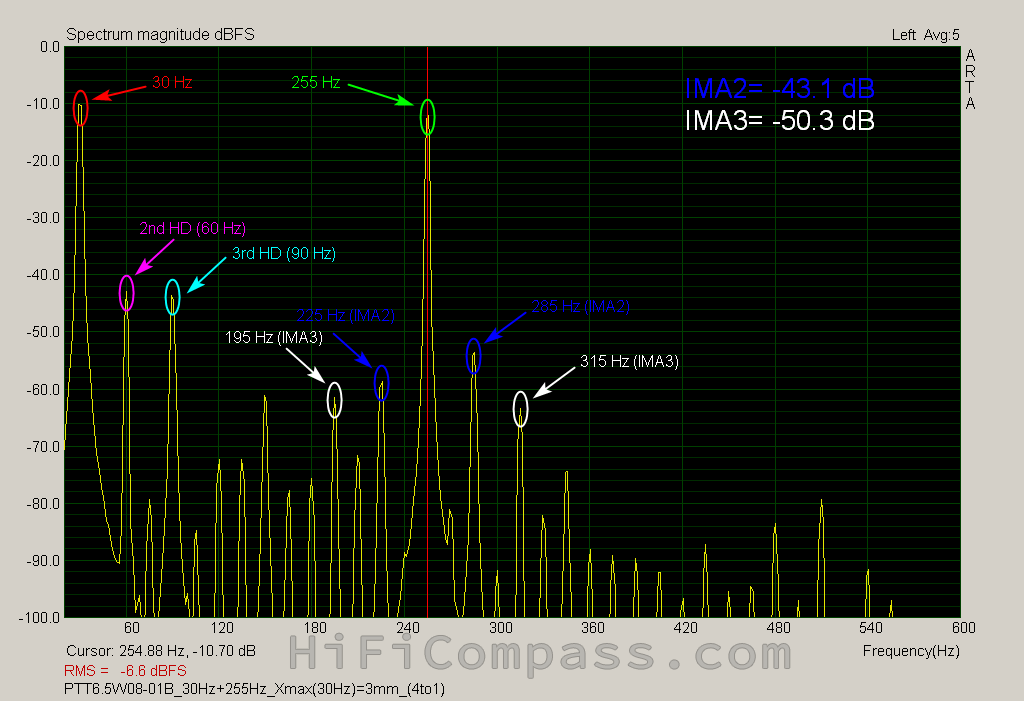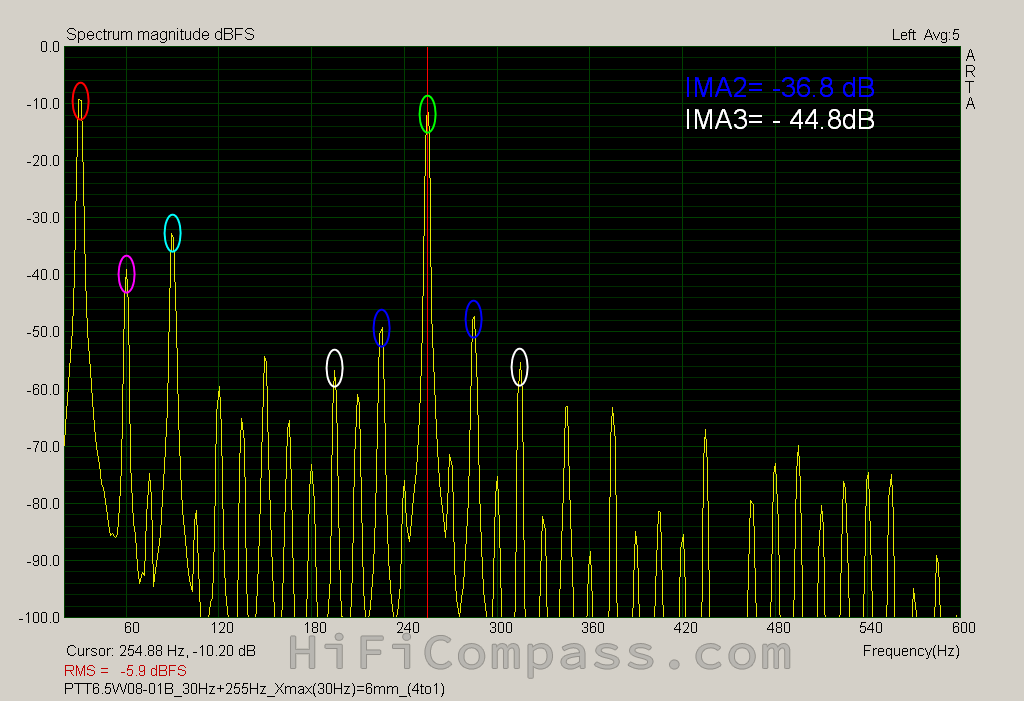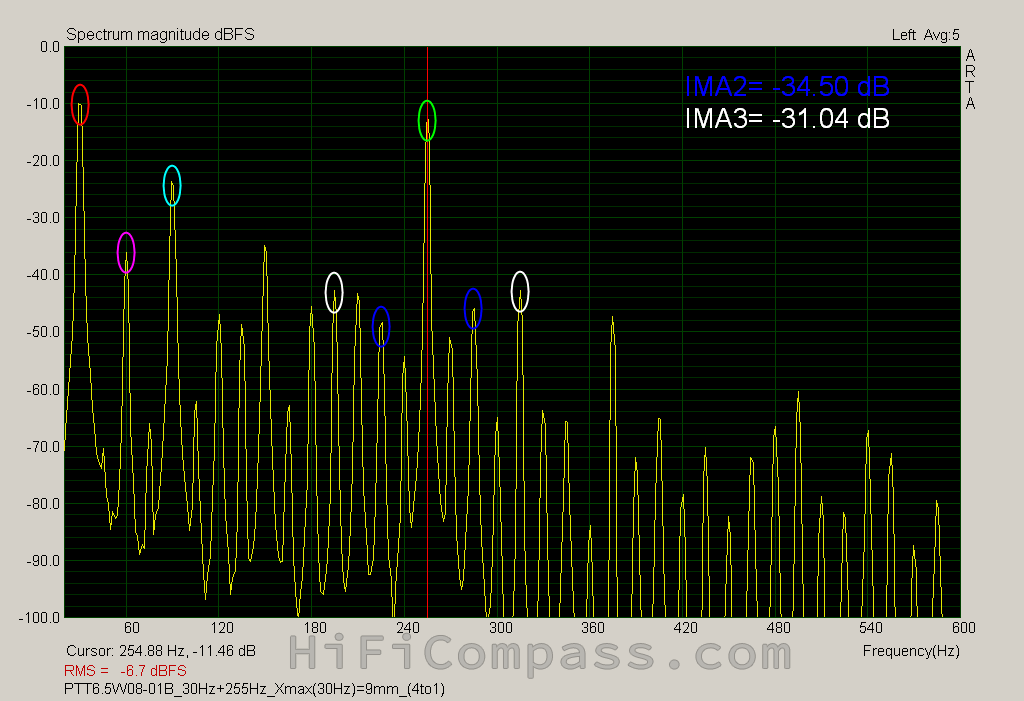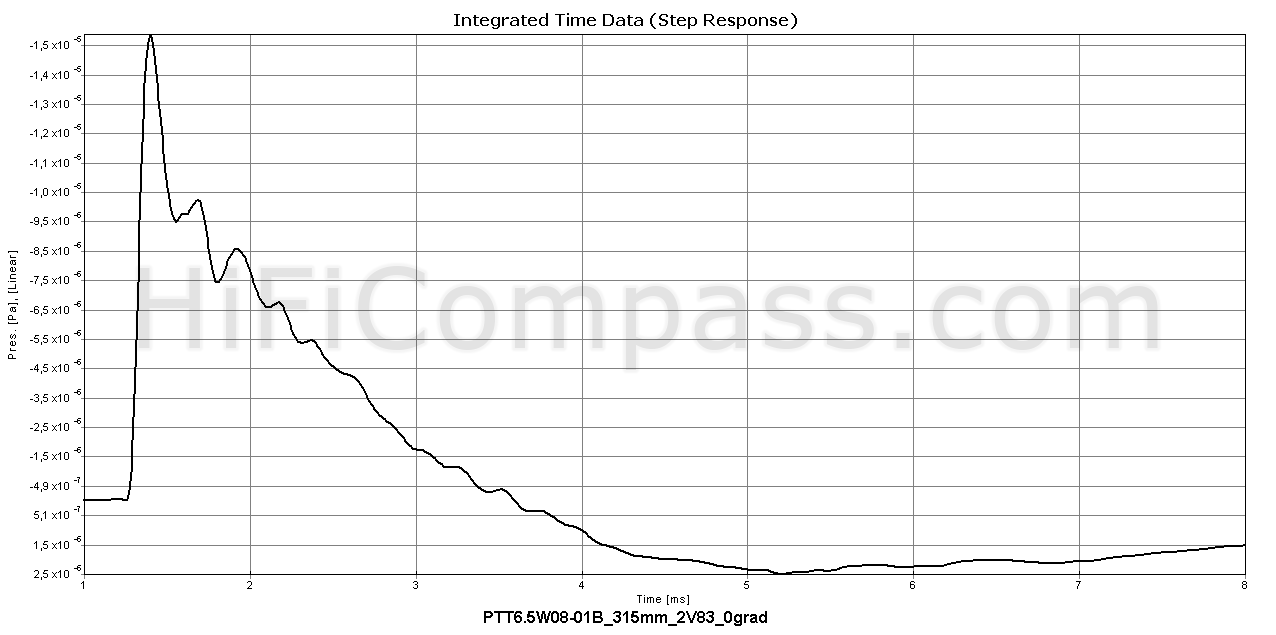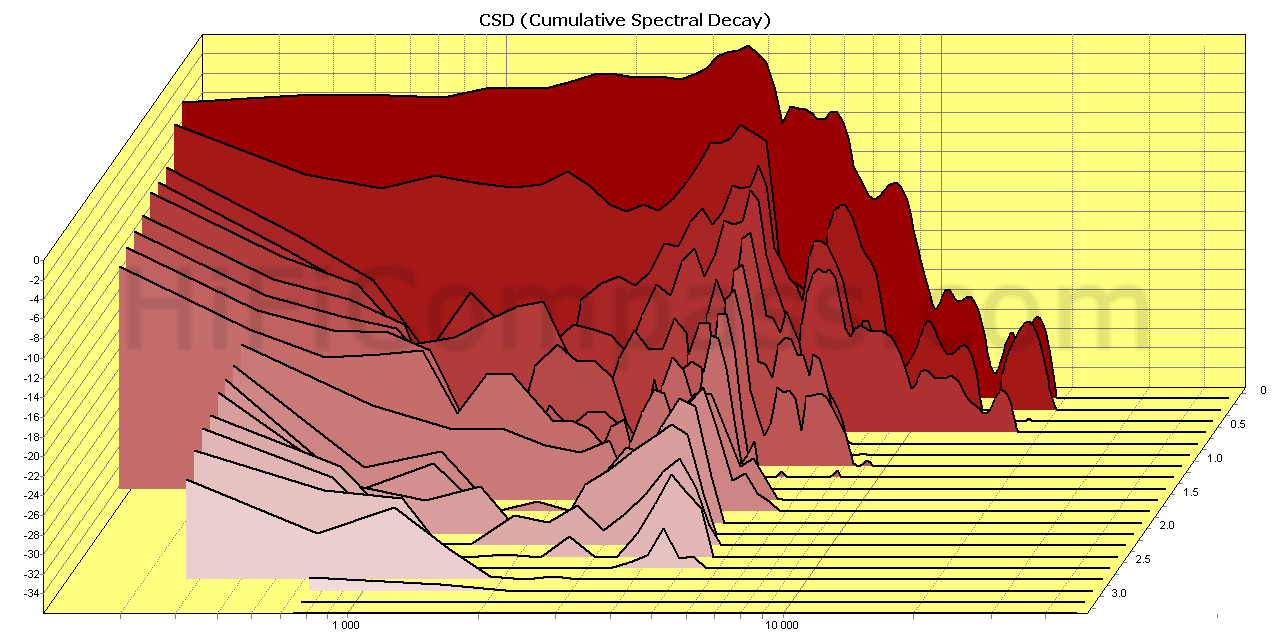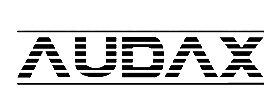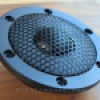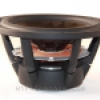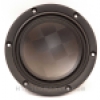HiFiCompass
Purifi PTT6.5W08-01B (PTT6.5X08-NFA-01)
What is on the test bench?
PTT6.5W08-01B is an 8-ohm version, I'm not afraid to say, of the revolutionary PTT6.5W04-01A midwoofer from the Danish company PURIFI. I thoroughly reviewed the 4-Ohm version almost a year and a half ago. Since the 8-Ohm version does not differ significantly from its 4-Ohm sibling, in order not to copy-paste myself, I strongly recommend that those who are not yet familiar with PURIFIand its products, first carefully read my review of PTT6.5W04-01A. You will learn from it about the Purifi team and all the innovative technical solutions and unique characteristics of this speaker. In this review I will try to focus on finding differences between the 8-Ohm and 4-Ohm versions and check if the "yellow jersey" of the tech leader in midwoofers has changed its colour.
You can read the history of the Purifi company here.
Why do we test this?
The midwoofer PTT6.5W08-01B (PTT6.5X08-NFA-01) was kindly provided for testing by PURIFI, for which I would like to express my deep gratitude to it, as well as personally to its members Lars Risbo and Claus Neesgaard for time spent discussing technical aspects related to design and technical solutions applied in the speaker driver. Further in the text on a highlighted background I will give several quotes from our dialogue, clarifying some points.
What did the manufacturer state?
So, the 8-ohm version came out a year after the debut of the "pilot" 4-ohm version. During this year the manufacturer made minor changes to the design, slightly improving it, correcting the parameters of the datasheets for both versions and, in connection with the expansion of the range of manufactured models, introduced a new system for naming speaker models.
Yes, the new notation system ... It seems that PURIFI, as a young company, is inspired by the success of its firstborn PTT6.5W04-01A and can now boldly look to the future and plan a significant expansion of the range of models. Expansion will naturally require a universal and logical organization of the notation system. I will not say that I am delighted with it. Maybe the age is already making itself felt, but long and not very intuitive names hardky remain in my head. We have to come up with some kind of associative connection. Fortunately, Claus Neesgaard gave an explanation of the new notation system, which should certainly help in remembering new names. I hope you find it useful too.
Claus Neesgaard: What seems so simple actually is quite tough. We actually started with the simpler scheme with the intention to just increment the model number from version to version, but already within the first year it became very difficult so handle. So we decided to expand the scheme a bit, example:
PTT: Purifi Transducer Technology
6.5: size
X=eXtended woofer; W=Woofer; S=Subwoofer, M=Midrange; T=Tweeter
04=4 ohm; 08=8 ohm and so on...
-
N=Neutral Surround Series; other letters for other series
F=paper/fiber cone; A=Alu Cone; other letters for other cone materials
A= sequential numbering (letter) for the motor design topology (no decoding scheme)
-
01= sequential numbering for version of the driver
A= sequential revision number (used for very minor modifications)
We’ll likely publish some info about how to decode it (like above, just easier to understand).
The datasheet have become even more detailed than before. Six diagrams reflecting the behavior of the speaker in various modes are now supplemented with four more, so there are now 10 (!) of them. The following types of measurements have been added:
- Inductance vs Voice Coil Position
- Current Harmonic Distortion @ 1 kHz, 0-28.3 Vrms
- Intermodulation Distortion @ 30 Hz 80 dB, 255 Hz 80 dB
- Intermodulation Distortion @ 50 Hz 80 dB, 425 Hz 80 dB
If we compare the datasheets of the first version of PTT6.5W04-01A, which was in my review, and the current one, you can find significant differences in the Thiel/Small parameters that affect a loudspeaker enclosure design:
- Qms was 8.3, now it is 5.8
- Qes was 0.33, now it is 0.28
- Qts was 0.32, naw it is 0.27
- Vas was 27.2 liters, now it is 25.9 liters
- The sensitivity has increased from 88.2 dB/2.83 volt*1 m up to 88.7 dB
An elementary substitution of parameters into the first simulator that came to the hand gives the recommended volume of the bass-reflex enclosure (Butterworth approximation) about 12.7 liters for the very first speaker driver model and only 6.1 liters for the current one. The difference is serious. It would be very interesting to know what is the reason for such a difference. Is this due to changes in the design or a diferent measuring procedure?
This is a comments from the manufacturer regarding the last question:
Lars Risbo:The moving mass and fs is unchanged so the compliance Cms/Kms is the same and this should not change Qe. The new measurement gives a lower Qms (lower impedance peak) which reduces Qts a tiny bit. The main difference comes from the Bl being raised from 7.5 in the old data sheet from your first review and the new data sheet having 8.1. We have bought our own magnetizer now and got the magnets energized at a subcontractor before. Our new machine is strong and we have optimized the placement of the magnet during the energize using fixtures so the result is much more consistent but it has also increased Bl. Now, Qes is inversely proportional to Bl squared so that gives a factor 1.17 change and combined with the lower Qms (solely from the changed measurement method) I think it perfectly explains the difference in Qts. A lower Qts points to a small box in for both sealed and ported as you calculate. One solution is to use a cross over inductor with more DC resistance (or even add resistance). This has the exact same effect as lowering Bl to raise Qts: same sensitivity but less power is burned inside the driver. The extra DC resistance needed is around 0.5-0.6 ohms (17% of the coil DC resistance of 3.5 ohms). Users of the driver in very small boxes with electronic bass EQ are very happy for the extra Bl since it burns a lot of power to compress the air in a small box and get to Xmax.
The 8 ohm version has a slightly lower coil mass so the motor is slightly weaker (Bl^2/Re is a little bit smaller) so this gives a slightly higher Qts.
Okay, now it's quite clear!
The following should be highlighted from the midwoofer parameters:
- The moving mass of the 8-ohm version is 2.3 grams lower than the 4-ohm version, 24.4 grams versus 26.7 grams
- The voice coil inductance of 0.53 mH is quite a high value, but in reality its absolute value is not as important as its stability with change of the voice coil current and the position of the voice coil, and with this PURIFI is simply excellent, much better than other manufacturers.
- High mechanical quality factor Qm=6.6
- Low sensitivity - 86.9 dB/2.83 volt*1m. In fact, it is very decent value for an 8-ohm midwoofer with an actual linear excursion of 9.8 mm. Compare, for example, with competitors:
ScanSpeak 18W/8531G00 - 87 dB (8 Ohm, Xlin=6.5 мм)
ScanSpeak 18W/8545-01 - 88 dB (8 Ohm, Xlin=6.5 мм)
ScanSpeak 18WU/8741T00 - 86 dB (8 Ohm, Xlin=9 мм)
Satori MW16P-8 - 87.5 dB (8 Ohm, Xlin=6 мм)
Seas W18EX-003 - 87 dB (8 Ohm, Xlin=5 мм)
Seas W18NX-001 - 87.5 dB (8 Ohm, Xlin=7 мм)
Seas W18NX-003 - 87.6 dB (8 Ohm, Xlin=7 мм) - The linear stroke of 9.8mm (!) in one direction is a very impressive figure, indeed a true long stroke!
Visual inspection
The workmanship, as in the PTT6.5W04-01A and PTT4.0W04-01A models, is top notch. No traces of glue, scratches, dirt or dust. No spots and dents on the cone. No chips on the ferrite magnet and no gaps and skewness anywhere. There is nothing to complain about.
What changes in the design can be visually detected in comparison with the firstborn PTT6.5W04-01A? So,
- The lead wires - in the current version they are made of flexible stranded copper wire, not silver plated one as before
- The surround is made of the same material, but it now looks matte instead of glossy. This makes it better in harmony with the membrane. In addition, the consistency of matte appearance in production is significantly better than glossy, which was one of the reasons for its choice. By the way, the letter "B" at the end of the old model name just means this modification
- The top flange of the magnet system is painted red - purely a matter of style, which is most likely responsible for a color palette that matches the style of the company's website.
- The terminal block is already pretty solid and matches the midwoofer status. It's made of thermosetting plastic, into which gold-plated blade terminals are pressed
- The midwoofer comes with a self-adhesive foam rubber gasket
Here, in fact, are all the modifications of the current version of the midwoofer compared to the first sample of 2019. A little bit, but all have a point.
The plots above shows at different scales the midwofer's impedance frequency responses. The green curve corresponds to the speaker after having been broken-in, the purple curve - before broken-in.
The measured resonant frequency Fs = 31.6 Hz and the total quality factor Qts = 0.31 almost perfectly coincide with the declared values Fs = 31 Hz and Qts = 0.30.
The measured mechanical quality factor Qm turned out to be lower than the declared one, 4.33 instead of 6.6, which is reflected in the height of the resonant peak of the impedance - 83 ohm measured value against 131 ohm in the datasheet.
The impedance curve is absolutely smooth and perfect, as is the case with the 4-ohm version. It is just almost impossible to find such an ideal response for a midwofer having a paper membrane.
The impedance increasing at high frequencies is slightly higher than in speakers with two-layer coils and due to the higher inductance. This fact in itself does not matter much if it is possible to ensure the constancy of this inductance and impedance at any the cone position.
The impedance frequency response is a visiting card of a speaker and says a lot. In this case it says about a moving system with low losses and a perfectly balanced cone driven by a good motor. Excellent!
The frequency responses of the 8-ohm and 4-ohm versions are identical, except for the behavior in the 3-4.5 kHz range, where the PTT6.5W08-01B has a small hump up to 2 dB. The measured sensitivity in the range from 300 Hz to 800 Hz averaged 85.5 dB, which is 1.4 dB lower than the declared 86.9 dB.
In general, the frequency response is very smooth in the range up to 1.3 kHz (unevenness in the band 130 - 1300 Hz is no more than +/- 1 dB) with a small and smooth rising of 2 dB to a frequency of 2.6 kHz. Starting from 4.1 kHz the frequency response begins to fall, almost monotonously, with a slope of about 20 dB/oct up to 40 kHz.
The frequency response is free of typical problem of surround/cone edge resonance in the 800 Hz - 2 kHz region and there are no signs of serious breakups. In my opinion, PTT6.5W08-01B has a fairly smooth and extended response, which does not require much effort when designing a crossover.
Off-axis frequency responses (315 mm)
Off-axis frequency responses are just as good as axial frequency response, there’s nothing to add. No hidden resonances were found.
Harmonic distortion (315 mm)
Above are the plots of harmonic distortion at average sound pressure levels of 85.5 and 100.5 dB. Here we analyze the frequency range from 200-300 Hz and above. Much more accurate data can be obtained from near-field measurements (at a distance of 5-20 mm) for frequencies below 200 Hz.
In general, the pattern and level of distortion of the 8-ohm version at the same sound pressure level corresponds to that of the 4-ohm version. Small differences in the behavior of various harmonics over the entire frequency range may be due to the individual characteristics of specific samples, but the general trend certainly remains. Distortion is very low, probably the lowest I have seen in a 6 "midwoofer.
The harmonic distortion measurements corresponds to the datasheet too. Excellent!
Harmonic distortion (5mm - 20 mm)
The graphs above show more accurate measurements of distortion below 200 Hz at 2.83 and 8 volts. They were obtained using the near-field measurement method.
At low frequencies the distortion for the 4-ohm version is slightly more favorable due to the lower level of the 4th and 5th harmonics. Otherwise, the behavior of both versions is close to each other.
The overall harmonic distortion level as for the 6" midwoofer can be rated as "very low". The lower limit of the frequency range, limited by distortion, can be considered as 30 Hz, which is very good.
Voice coil current harmonic distortion
This type of measurement, despite its simplicity, is an excellent tool for assessing the linearity of a speaker motor. The above plots show the frequency dependences of the 2nd, 3rd, 4th and 5th harmonics of the voice coil current at 2.83 and 8 volt. To limit the speaker overload in terms of the membrane displacement when measuring harmonic distortion, a second-order Butterworth type high-pass filter with a cutoff frequency of 50 Hz was used.
Voice coil current nonlinearity is the direct nonlinearity of the mechanical force driving the speaker cone, since this force is related to the current by a simple relationship F=B*L*I, where B is the magnetic field strength, L is the length of the voice coil wire inside the magnetic gap and I is the current. So, in principle, it is practically impossible to obtain sound pressure distortion lower than current distortion in the frequency range where the contribution of the motional nonlinearity becomes insignificant.
We don't even need to talk about the fourth and fifth harmonics above 100 Hz. The second harmonic of the current also linearly depends on the voltage level, as well as the second harmonic of the sound pressure. The third harmonic above 150 Hz is almost independent of the input voltage. Below 150 Hz, due to an increase in the membrane displacement amplitude, a sharp increase in harmonics of all orders begins.
I would rate the current distortion level as "very low". This type of measurement once again confirms that the PTT6.5W08-01B midwoofer motors are the most linear ones I have tested to date.
The intermodulation distortion measurement is one of way of analyzing device non-linearity. It is not an alternative, but an additional method and allows you to identify the spectral components of the inharmonious structure, which are much more harmful for high-quality sound reproduction and to which our hearing is more sensitive
There is a very good article of Bruno Putzeys - "Distortion, The Sound That Dare Not Speak Its Name", in which he very well describes the mechanism of the intermodulation distortion occurrence in a midwoofer, at second, an one interesting experiment that everyone can do. Its essence is the simultaneous supply of a musical signal to a midwoofer with a singing rather than speech (for better audibility of the effect), male or female vocals, or a violin, clarinet, flute, and sine signal with frequency of 30 Hz, the level of which can be adjusted. The sine signal causes a large cone excursion, which leads to the appearance of non-linearity of the suspension and the force factor. The suspension nonlinearity leads only to the appearance of harmonic distortions of the 30 Hz sine signal and does not affect the reproduction of midrange, while the modulation of the force factor leads to a change in the sensitivity of the speaker for midrange frequencies. This changing is manifested in the amplitude modulation of the voice notes with 30 Hz sine. Do such an experiment yourself and you will be very surprised at how much intermodulation distortion is heard and how they grow with an increase in the low-frequency component. Perhaps this will be a great discovery for you.
For testing I chose the frequencies of 30 Hz and 255 Hz. With this ratio (1:8.5) the contribution of Doppler distortion is not yet dominant and the contribution of amplitude modulation can still be observed. In addition, this is a very realistic situation that occurs in both two-way and three-way systems. The measurements were performed for different 30 Hz cone excursions and their conditions are indicated in the lower left corner of each plot. By various colors are indicated:
- test frequencies
- 2nd order harmonic distortion components for the test frequencies (2nd HD)
- 3rd order harmonic distortion components for the test frequencies (3rd HD)
- 2nd order intermodulation distortion amplitude (IMA2)
- 3rd order intermodulation distortion amplitude (IMA3)
However, in these plots products of the motor nonlinearity are mixed with products of inevitable frequency modulation of the Doppler effect. How do you define who is who? We can analytically estimate the level of the first pair of the side Doppler components using the following formula [http://www.linkwitzlab.com/frontiers.htm#J]:
For 6 mm = -36.8 dB
For 9 mm = -34.5 dB
Step response
The step response shows excellent slew rate and fast falling. The returning to a start position is monotonous. Small disturbances in the region of 1.5-2.3 ms correspond to approximately 4 kHz, where the frequency response has a small hump. Good transient response.
Waterfall
The waterfall shows the same effects as a step response, in addition exposing hidden resonances that are difficult to see in other types of measurements. In this case an echoes of resonance are observed near 4 kHz. The tail is not very long and already after about the time of 2.7 ms is reduced to a threshold of visibility.
It seemed to me that the main resonance of the membrane is slightly shifted in frequency higher for the 8-ohm version. Its tail stretches in the range of about 4 - 4.2 kHz, and for the 4 ohm version - in the range of 3.5 - 3.8 kHz. This is a small but argument in favor of the 8-ohm version. I think it's not even about a speaker nominal impedance. Whether this is due to the improvement of the membrane properties over the year of speaker design perfectioning or their change from batch to batch, it is better to ask the manufacturer.
Listening impressions
Thanks to a low resonance frequency (30Hz) supported by a huge linear stroke (10mm) and very low distortion, this midwoofer can dig really deep. You can find many 6 "midwoofers with similar resonance frequency and 6-7mm linear stroke, but I can assure you their lower bass quality will be definitely worse. PTT6.5W simultaneously with heavy work on a large amplitude at the lowest frequencies does not lose grip and articulation on the middle and upper bass. Bass completely retains the right structure, density, does not increase its tonality and not become thinner due to the enrichment by a forest of parasitic harmonics. It is clean and accurate, and this is due to the extremely low intermodulation distortion. There is no audible distortion at any volume level. Beyond the maximum allowable input signal you will simply hear the voice coil bump on the magnet system. The extremely low aerodynamic noise of the moving system is impressive, even with an amplitude of 10 mm at 30 Hz.
Bass timbre. Due to the low distortion and lack of second harmonic dominance in the distortion spectrum, I would characterize the bass as very accurate, correct and analytical. It makes it possible to hear the bass exactly as it is, without false embellishment. This is real clean bass. On the other hand, subjectively, the middle/upper bass and lower mids lack the familiar warmth and fullness, which makes the sound in this range drier and thinner compared to the usual sound of other Scandinavian brands paper midwoofers. At this point, every one chooses his own - either accurate, articulated, transparent, but a little dryish and thin bass, or fat, more voluminous, thick, warm and full, but a little blurry, dirty, less dense and less legible.
The mid and upper midrange are very clean, transparent, contrasting and dynamic. Their transparency surprises and allows you to hear new nuances on old well-known recordings and not only hear musical instruments, but literally see them. It's worth a lot.
The steep and monotonous frequency response roll-off beyond 4 kHz quickly cuts off the rest of the audio spectrum, which, in my opinion, makes the sound a little spatially compressed, reduces its perceived depth and atmosphere compared to midwoofers, which have a more extended frequency response. To my ears, this effect feels like a decrease in the reverberation in the high midrange, that is, a decrease in the size of the virtual concert hall. On some music tracks this is a positive effect, which improves the localization of images and makes them more energetic, while for others it is a negative effect that reduces the space of the soundstage.
In general, the PTT6.5W08-01B sound perfectly combines the best features of the energy and transparency of speakers with hard metal and ceramic cones with the euphony and richness of the timbre of paper cone speakers.
"How to use" recomendations
To my recommendations for the use of PTT6.5W04-01A, I would like to add that after extensive testing of both 4-ohm and 8-ohm models in the "Passive radiator" type loudspeaker enclosures with an internal volume of 12 to 20 liters, the most optimal sound is obtained in volume 14-15 liters. In this case the optimal balance is achieved between the depth of the bass and its energy, density, elasticity and punch. At 20 liters it becomes very deep, but sluggish, and at 12 liters it is already dry.
What is the price and where to purchase it?
You can buy PTT6.5W08-01B midwoofers both directly from PURIFI and in various online stores. The retail price is in the range of €303-369/unit excluding VAT.
- https://purifi-audio.com/vare/ptt6-5x0z-nfa-01/
- https://www.soundimports.eu/en/purify-ptt65x08-nfa-01.html
- https://www.madisoundspeakerstore.com/approx-6-7-woofers-purifi/purifi-a...
Summary
The testing confirmed almost complete compliance of all measured parameters and characteristics with the declared ones, with the exception of the sensitivity, the mechanical quality factor Qms and the height of the impedance resonant peak, which turned out to be slightly lower than those declared.
The record low level of harmonic and intermodulation distortion makes the PTT6.5W08-01B the absolute leader in linearity among all 6" midwoofers on the market today. I think it can be taken as a reference point.
The 8-ohm model PTT6.5W08-01B, released a year after the appearance of the very first 4-ohm version, has undergone minimal design and cosmetic changes that are definitely positive, giving it an absolutely finished look. In terms of its characteristics, the 8-ohm version does not fundamentally differ from the 4-ohm version, but it even has a slightly extended frequency response and a smaller moving mass.
So, it can be highlighted for the PURIFI PTT6.5W08-01B midwoofer:
- Modest sensitivity - 85.5 dB/2.83 volt*1 m
- Huge linear voice coil excursion - 9.8 mm per one way
- Really working PURIFI Neutral Surround technology
- Hard cellulose based fibers filled cone having no any serious breakups
- Very even sound pressure frequency response
- Very low harmonic distortion
- Very low motor air noise at low frequencies
- Excellent intermodulation distortion
- Very good craftmanship
- Excellent impedance frequency response
- Can be used in 2-way loudspeaker up to the 3 kHz crossover point
- The moving mass is 2.3 grams lower compared to the 4-ohm version - 24.4 grams vs 26.7 grams
You can get more information about the measurement results here.
Yevgeniy Kozhushko/04.05.2021
P.S.
Some comments regarding the discrepancy between the measured sensitivity and its datasheet value:
Lars Risbo: The only strange detail is the mismatch in sensitivity. I have no explanation for that.
Yevgeniy Kozhushko: The discrepancy of the measured sensitivity may be due to an error in my measurement setup too, an error in averaging, and a finite size test baffle. Measuring absolute sensitivity is not as easy as it might seem at first glance. For example, your absolute error in the datasheet and mine may have different signs (+ and -), so the discrepancy will be the sum of our errors.
Lars Risbo: Yes, it is a challenge to calibrate everything in the chain and the tolerance doubles when comparing two setups. There is also unit to unit variation but should be somewhat smaller. We have more data from the production so we can publish statistics at some point.
CONTACTS
- Ukraine
- (+380) 95 904 7827
- hificompass@gmail.com
LAST NEWS
-
27 Mar 2025
-
04 Mar 2025
-
25 Feb 2025
-
10 Feb 2025
